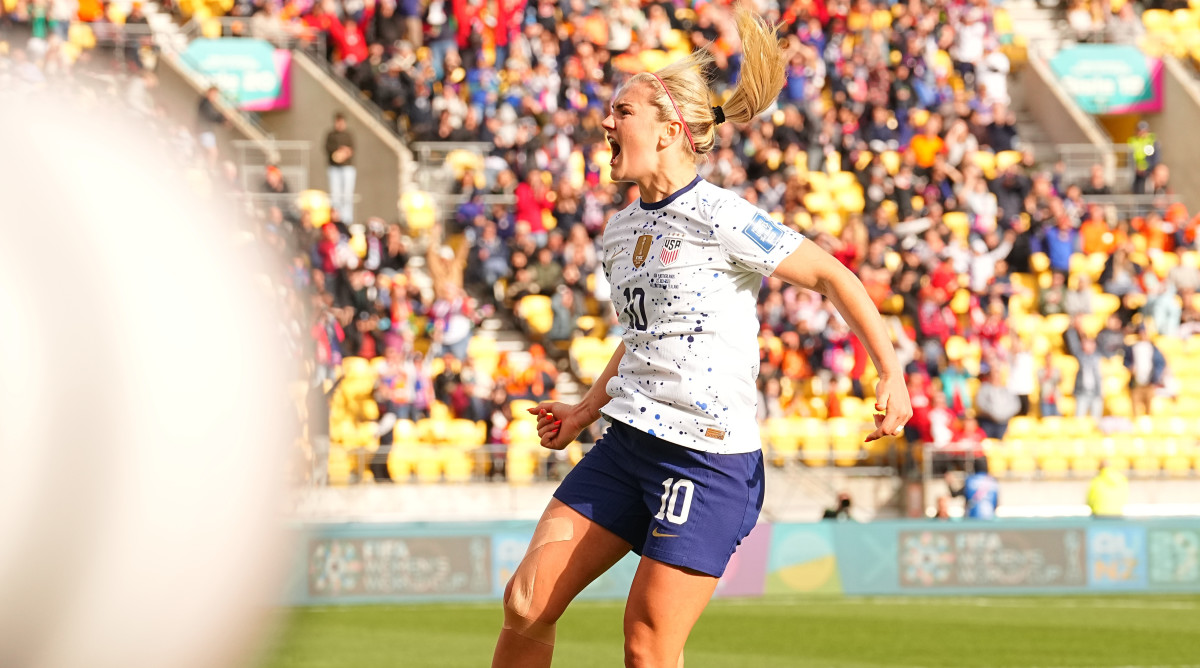SI:AM | The USWNT Isn’t Invincible

Good morning, I’m Dan Gartland. Last night was more tense than I’m used to USWNT games being.
In today’s SI:AM:
🇺🇸 The U.S. claws back against the Netherlands
If you're reading this on SI.com, you can sign up to get this free newsletter in your inbox each weekday at SI.com/newsletters.
Phew
The U.S. women’s national team found itself in an unfamiliar position Thursday against the Netherlands. With Jill Roord’s 17th-minute goal, the U.S. trailed for the first time at a Women’s World Cup since the 2011 quarterfinal against Brazil. But thanks to Lindsey Horan’s header in the 62nd minute off a corner kick, the Americans were able to come away with a 1–1 draw and avoid a disaster.
The game exposed two main problems with this U.S. team. The first was the inconsistency of the American midfield. The Dutch dominated possession in the first half as the U.S.’s midfield trio of Savannah DeMelo, Lindsey Horan and Andi Sullivan was outplayed by its Oranje counterparts. That deficiency led directly to the Dutch goal, Clare Brennan writes:
The Dutch wasted no time exposing the USWNT’s frailty down the spine of the pitch, commanding the center of the park. Unsurprisingly then, the Netherlands’ opening goal came from a breakdown in center midfield, with Lieke Martens beating Sullivan, before charging toward the U.S.’s box, with the play culminating into a well-struck shot from Jill Roord.
Hunting for an equalizer, the U.S. began to chase the Dutch around the park as the Netherlands increasingly dictated pace and tempo as the first half wore on, ending the opening frame with 61% of the possession to the USWNT’s 31%. The halftime whistle couldn’t come soon enough for the reigning World Cup champions.
Part of the trouble was DeMelo, who was making just her second start for the national team and her third appearance overall. But U.S. coach Vlatko Andonovski is in a difficult spot because one of the team’s best midfielders, Rose Lavelle, is on a minutes restriction as she works her way back from a knee injury, hence the decision to start DeMelo. Andonovski could choose to move Julie Ertz from center back to the midfield, but that risks weakening the team’s defense—solving one problem while creating another. Lavelle changed the tenor of the game when she was subbed on at halftime for DeMelo, though, helping to control possession and create offensive opportunities. But if she remains unable to play a full 90 minutes, the U.S. needs to find a way to keep its head above water without her on the field.
The second main issue was the inability to finish offensive opportunities. The U.S. had 18 shots, but only four were on target. The three forwards (Alex Morgan in the middle, and Sophia Smith and Trinity Rodman on the flanks) failed to convert a number of promising chances in front of goal. This is where Andonovski’s decisions as coach come into question again. The U.S. has other attacking options available (namely Alyssa Thompson and Lynn Williams), but Andonovski kept them on the bench. In fact, the Lavelle halftime sub was the only change Andonovski made all game. In the interest of keeping players fresh over the course of a long tournament, as well as providing a spark to an attack that has failed to impress over the first two games, Andonovski should consider letting some other players get a chance up front.
Up next for the U.S. is the group-stage finale against Portugal on Tuesday at 3 a.m. ET. The draw against the Netherlands made advancing out of the group far more likely than it would have been with a loss. All the U.S. needs to do is draw the final game to advance. The Americans are also in prime position to win the group if they beat Portugal, thanks to goal differential. Because the U.S. beat Vietnam 3–0 and the Netherlands beat Portugal 1–0, the U.S. can win the group with a victory over Portugal as long as the Netherlands doesn’t blow out Vietnam.
The best of Sports Illustrated

- While the USWNT’s win last night wasn’t pretty, it showed the team’s willingness to fight, Michael Rosenberg writes.
- Tom Verducci had the scoop last night that the Angels were taking Shohei Ohtani off the trade market.
- Hours after Verducci broke that news, the Angels traded for one of the top pitchers available: White Sox starter Lucas Giolito.
- The other noteworthy trade made last night was the Dodgers’ acquisition of Amed Rosario from the Guardians. Emma Baccellieri called the deal “a clear (if small) win” for Los Angeles.
- Bob Harig has the details of the wide-ranging memo PGA Tour commissioner Jay Monahan sent to players yesterday, addressing numerous important topics like the LIV merger and proposed equipment changes.
- Northwestern did interim football coach David Braun dirty by leaving him to answer every question about the school’s hazing scandal at Big Ten media days, Pat Forde writes.
- Minnesota is the latest Big Ten football program to face allegations of a toxic environment.
- Nigeria is on the cusp of an improbable trip to the World Cup knockout round after an upset victory over Australia.
The top five...
… things I saw last night:
5. Yankees pitcher Carlos Rodón covering up the stupid advertising patch on the team’s classic pinstripes.
4. Joey Votto’s interview with Chris “Mad Dog” Russo. (I still can’t tell how serious he was being in attacking Russo.)
3. The swing Adley Rutschman put on this home run.
2. The benches clearing in Houston after Adolis García’s home run for the Rangers.
1. Matt Wallner’s long opposite-field home run.
SIQ
On this day in 2011, the Mets traded Carlos Beltrán to the Giants in a one-for-one deal for which then 21-year-old future All-Star pitcher?
- Jacob deGrom
- Matt Harvey
- Zack Wheeler
- Noah Syndergaard
Yesterday’s SIQ: On this day in 2011, the Pirates and Braves played the longest game in the long history of both franchises. How many innings were played before it ended on a blown call at the plate?
- 15
- 19
- 22
- 25
Answer: 19. There have been 46 games in MLB history that have lasted at least 20 innings, so it’s pretty amazing that Pittsburgh and Atlanta—two of the five oldest teams in the league—haven’t had one. The Pirates’ and Braves’ previous longest games were both 18 innings and both, coincidentally, in 2006.
The 19-inning game ended at 1:50 a.m., when Atlanta pitcher Scott Proctor hit a grounder to third with runners on second and third and one out. Pittsburgh third baseman Pedro Álvarez fielded and threw home. His throw easily beat Julio Lugo to the plate, and catcher Michael McKenry applied the tag. But home plate umpire Jerry Meals called Lugo safe. It was an unfathomably bad call and it sent Pirates manager Clint Hurdle into a rage. In the days before replay review, though, there was nothing that could be done to overturn the call. The next day, Pittsburgh filed an official protest with the league. MLB executive vice president Joe Torre released a statement acknowledging that the call was wrong, but it was not overturned.
